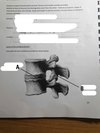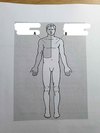Back, Lymphatics and Nerves COPY Flashcards
What is A?

Lamina
What is B?

Transverse process
What is C?

Pedicle
What is D?

Body
What is E?

Vertebral column
What is F?

Superior facet
What is G?

Spinous process
What is A?

Vertebral notch
What is the most anterior and posterior structures?

Anterior is D (body)
Posterior is G (spinous process)
What is found inside the intervertebral foramen (vertebral canal, E)?

Spinal cord
What joint occurs between the adjacent bodies of vertebrae (D)?

Secondary cartilaginous
What joint is found between the articular facet of adjacent vertebrae?
Synovial plane
Where does a vertebrae articulate onto a rib?
Tubercle
Where to adjacent vertebrae articulate?
Body and facets
What are the different kinds of vertebrae of the spinal column?
Cervical
Thoracic
Lumbar
Sacral
Coccygael
How many of each vertebrae are there?
7 cervical
12 tharacic
5 lumbar
5 sacral
1 coccygael
What is the name of C1?
Atlas
What is the name of C2?
Axis
What is the name of C7?
Prominant vertebrae
What is the atlas and axis?
First and second vertebrae (C1 and C2)
What distinguishes cervical vertebrae from the rest?
Transverse foramen present
Smallest
Bifid spinous process
What distunguishes thoracic vertebrae from the rest?
Long sharp, spinous process
Body is heart shaped
What distinguishes lumbar vertebrae from the rest?
Largest body
Big, blunt spinous process
What is A?

Intervertebral disk













































































































